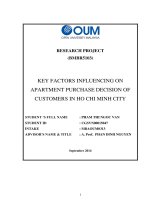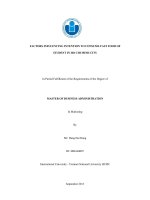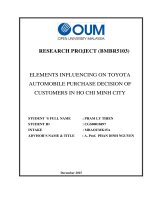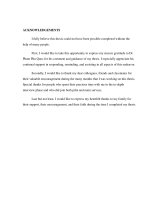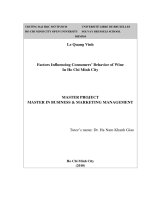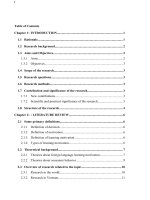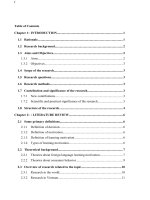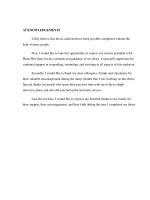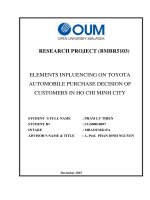Factors influencing intention to consume fast food of student in ho chi minh city
Bạn đang xem bản rút gọn của tài liệu. Xem và tải ngay bản đầy đủ của tài liệu tại đây (1.09 MB, 88 trang )
FACTORS INFLUENCING INTENTION TO CONSUME FAST FOOD OF
STUDENT IN HO CHI MINH CITY
In Partial Fulfillment of the Requirements of the Degree of
MASTER OF BUSINESS ADMINISTRATION
In Marketing
By
Mr: Dang Hai Dang
ID: MBA04007
International University - Vietnam National University HCMC
September 2013
FACTORS INFLUENCING INTENTION TO CONSUME FAST FOOD OF
STUDENTS IN HO CHI MINH CITY
In Partial Fulfillment of the Requirements of the Degree of
MASTER OF BUSINESS ADMINISTRATION
In Marketing
by
Mr: Dang Hai Dang
ID: MBA04007
International University - Vietnam National University HCMC
September 2013
Under the guidance and approval of the committee, and approved by all its members, this
thesis has been accepted in partial fulfillment of the requirements for the degree.
Approved:
---------------------------------------------Chairperson
--------------------------------------------Committee member
---------------------------------------------Committee member
--------------------------------------------Committee member
---------------------------------------------Committee member
--------------------------------------------Committee member
Acknowledge
I am particularly grateful to my advisor Dr. Ho Thi Bich Van for the support of my
Master study and research. Her guidance helped me a lot in all time of research and writing of
this thesis.
I wish to express my deep sense of gratitude to my dissertation committee members:
Dr. Nguyen Quynh Mai and Dr. Mai Ngoc Khuong who gave me valuable comments on the
thesis proposal and helped me to increase the quality of the thesis.
Finally, my special thanks are extended to everyone who supported and helped me to
complete research work directly or indirectly.
-i-
Plagiarism Statements
I would like to declare that, apart from the acknowledged references, this thesis either
does not use language, ideas, or other original material from anyone; or has not been
previously submitted to any other educational and research programs or institutions. I fully
understand that any writings in this thesis contradicted to the above statement will
automatically lead to the rejection from the MBA program at the International University –
Vietnam National University Hochiminh City.
- ii -
Copyright Statement
This copy of the thesis has been supplied on condition that anyone who consults it is
understood to recognize that its copyright rests with its author and that no quotation from the
thesis and no information derived from it may be published without the author’s prior consent.
© Dang Hai Dang / MBA04007 / 2011-2013
- iii -
Table of Contents
Chapter I - Introduction ......................................................................................................1
1.1. Fast food market .................................................................................................1
1.2. Rationale and problem statement ........................................................................2
1.3. Research question ...............................................................................................3
1.4. Research objectives.............................................................................................3
1.5. Research methodology ........................................................................................4
1.6. Structure of research ...........................................................................................4
Chapter II - Literature review ............................................................................................5
2.1. Intention ..............................................................................................................5
2.2. Attitude Toward the Behavior ............................................................................5
2.3. Subjective Norm .................................................................................................6
2.4. Perceived Behavioral Control .............................................................................6
2.5. Research Model ..................................................................................................7
Chapter III - Methodology ..................................................................................................8
3.1. Research Process.................................................................................................8
3.2. Research Method ................................................................................................9
3.2.1. Research Sample ......................................................................................9
3.2.1.1. Research population an sample size ...........................................9
3.2.1.2. Sampling method ........................................................................10
3.2.2. Questionnaire design ................................................................................11
- iv -
3.2.2.1. Questionnaire structure ...............................................................11
3.2.2.2. Measurement scale and coding ...................................................12
3.2.3. Data analysis.............................................................................................14
3.2.3.1. Descriptive Statistics...................................................................14
3.2.3.2. Reliability test .............................................................................15
3.2.3.3. Exploratory Factors Analysis ......................................................15
3.2.3.4. Correlation test ............................................................................15
3.2.3.5. Multiple Linear Regression Analysis..........................................15
Chapter IV - Data analysis and result................................................................................16
4.1. Sample description ..............................................................................................16
4.1.1. Respondents' information .........................................................................16
4.1.2. Respondents' fast food habit .....................................................................25
4.2. Descriptive statistics ...........................................................................................30
4.2.1. Attitude toward the behavior ....................................................................31
4.2.2. Subjective norm........................................................................................31
4.2.3. Perceived Behavioral Control ..................................................................32
4.2.4. Consumption intention .............................................................................33
4.3. Reliability test .....................................................................................................33
4.3.1. Attitude toward the behavior ....................................................................33
4.3.2. Subjective norm........................................................................................37
4.3.3. Perceived Behavioral Control ..................................................................37
-v-
4.3.4. Consumption intention .............................................................................38
4.4. Exploratory Factors Analysis ..............................................................................38
4.4.1. Exploratory Factor Analysis of Independent Variable .............................38
4.4.2. Exploratory Factor Analysis of Dependent Variable ...............................41
4.5. Revised Research Model.....................................................................................43
4.6. Summary of hypothesis for revised research model ...........................................46
4.7. Correlation test ....................................................................................................46
4.8. Multiple Linear Regression Analysis..................................................................58
Chapter V - Conclusion and Marketing Strategy .............................................................51
5.1. Conclusion ..........................................................................................................51
5.2. Marketing Strategy..............................................................................................52
5.2.1. Marketing segmentation strategy .............................................................52
5.2.2. Objective strategy .....................................................................................53
5.2.3. Marketing Mix..........................................................................................54
5.2.3.1. Product ........................................................................................54
5.2.3.2. Price ............................................................................................55
5.2.3.3. Place ............................................................................................55
5.2.3.4. Promotion ....................................................................................55
i) Advertising ..............................................................................55
ii) Sales Promotion .....................................................................58
iii) Direct Marketing ...................................................................59
- vi -
- vii -
List of Tables
Table 3.1. Measurement scale ................................................................................................14
Table 4.1. BMI category ........................................................................................................19
Table 4.2. Descriptive Statistics of Attitude Toward the Behavior .......................................31
Table 4.3. Descriptive Statistics of Subjective Norm ............................................................31
Table 4.4. Descriptive Statistics of Perceived Behavioral Control........................................32
Table 4.5. Descriptive Statistics of Consumption Intention ..................................................33
Table 4.6. Reliability Statistics of Attitude Toward the Behavior (1) ...................................33
Table 4.7. Item-Total Statistics of Attitude Toward the Behavior (1) ...................................34
Table 4.8. Reliability Statistics of Attitude Toward the Behavior (2) ...................................34
Table 4.9. Item-Total Statistics of Attitude Toward the Behavior (2) ...................................34
Table 4.10. Reliability Statistics of Attitude Toward the Behavior (3) .................................35
Table 4.11. Item-Total Statistics of Attitude Toward the Behavior (3) .................................35
Table 4.12. Reliability Statistics of Attitude Toward the Behavior (4) .................................35
Table 4.13. Item-Total Statistics of Attitude Toward the Behavior (4) .................................36
Table 4.14. Reliability Statistics of Attitude Toward the Behavior (5) .................................36
Table 4.15. Item-Total Statistics of Attitude Toward the Behavior (5) .................................36
Table 4.16. Reliability Statistics of Subjective Norm............................................................37
Table 4.17. Item-Total Statistics of Subjective Norm ...........................................................37
Table 4.18. Reliability Statistics of Perceived Behavioral Control .......................................37
Table 4.19. Item-Total Statistics of Perceived Behavioral Control .......................................37
Table 4.20. Reliability Statistics of Consumption Intention ..................................................38
Table 4.21. Item-Total Statistics of Consumption Intention..................................................38
Table 4.22. KMO and Bartlett's Test (1) ...............................................................................39
Table 4.23. Total Variance Explained (1)..............................................................................39
- viii -
Table 4.24. Component Matrix (1) ........................................................................................40
Table 4.25. Rotated Component Matrix (1) ...........................................................................41
Table 4.26. KMO and Bartlett's test (2) .................................................................................42
Table 4.27. Total Variance Explained (2)..............................................................................42
Table 4.28. Component Matrix .............................................................................................42
Table 4.29. Rotated Component Matrix ...............................................................................42
Table 4.30. Variables and Measurement Items ......................................................................43
Table 4.31. Variables and Items' description .........................................................................45
Table 4.32. Correlations.........................................................................................................47
Table 4.33. Model summary ..................................................................................................48
Table 4.34. Anova ..................................................................................................................49
Table 4.35. Coefficients .........................................................................................................49
Table 4.36. Hypothesis testing result .....................................................................................50
Table 5.1. Gift coupon ...........................................................................................................56
Table 5.2. Group discount......................................................................................................59
- ix -
List of Figures
Figure 2.1. Research model ...................................................................................................7
Figure 3.1. Research Process .................................................................................................8
Figure 4.1 Percentage of respondents' gender .......................................................................16
Figure 4.2. Percentage of respondents' gender and University .............................................17
Figure 4.3. Percentage of respondents' years .........................................................................18
Figure 4.4. Percentage of respondents' Native village ...........................................................18
Figure 4.5. BMI of respondents .............................................................................................20
Figure 4.6. Respondents' monthly income .............................................................................21
Figure 4.7. Respondents' payment for each time eating ........................................................22
Figure 4.8. Respondents' monthly eating expenditure ...........................................................22
Figure 4.9. Respondents' consuming fast food frequency .....................................................23
Figure 4.10. Fast food restaurant brand names ......................................................................24
Figure 4.11. Fast food brand names with payment for each time eating ...............................25
Figure 4.12. Fast food dishes .................................................................................................26
Figure 4.13. When respondents often have fast food.............................................................27
Figure 4.14. Where respondents often have fast food ...........................................................27
Figure 4.15. With people they often have fast food...............................................................28
Figure 4.16. Respondents' occasions for having fast food .....................................................29
Figure 4.17. Meals which respondents often eat fast food for ...............................................30
Figure 4.18. Revised Research Model ...................................................................................45
-x-
- xi -
Abstract
This study aimed to explore factors influencing fast food consumption intention of
students who study or live in Vietnam National University Village, HCMC by applying
Theory of Planned Behavior. A total of 400 students (46.8 % male) were surveyed with a
questionnaire. Descriptive statistics, Reliability test, Exploratory Factors Analysis (EFA),
Correlation test and Multiple Linear Regressions Analysis were performed in analyzing the
data. The most popular fast food dishes in descending order were Fired chicken (73%),
French fries (58.8%), Hamburger (49.2%) and Pizza (42.5%). Exploratory factors analysis
(EFA) grouped the items into 6 variables: Subjective Norm, Perceived Behavioral Control,
Risk Awareness, Motivation, Attitude toward the Behavior and Intention. Multiple Linear
Regressions Analysis showed that fast food consumption intention was significantly related
to Subjective Norm (b=0.137, P=0.006), Perceived Behavioral Control (b=0.394, P=0), Risk
Awareness (b=0.141, P=0.012) and Attitude Toward the Behavior (b=0.14, P=0.008).
Motivation was not significantly related to consumption intention (b=0.065, P=0.059). The
finding of the study was used to build up the marketing strategy for the new fast food
restaurant Loca Loca which located in Vietnam National University Village, HCMC.
Keywords:
BMI
Body mass index
EFA
Exploratory Factors Analysis
HCMC
Ho Chi Minh City
VNU
Vietnam National University
- xii -
- xiii -
Chapter I - Introduction
1.1.
Fast food market
Nowadays, with the development of society, people not only satisfy with basic
needs but also rise up to a higher level of security needs, fame, social status, etc.
Eating not only to feel full but also must be delicious, beautiful and hygienic. Eating
has demonstrated personal style, through eating humans express themselves, beside
they want to explore new things in food taste, want to experience the wonderful
feeling.
Fast food is suitable for busy life when time becomes precious, for saving time
and still providing enough energy for people. Understanding the needs of fast foods
for humans in modern life and the development trends of current epoch, the restaurant
constantly making strategies, developing solutions to fast food service to make this
service becoming closer and more convenient to people. Therefore, fast food service
is becoming a business with high profits.
In recent years, the fast food market in Vietnam has been particularly vibrant
with the expansion of many famous brands such as KFC, Lotteria, etc. and other big
names in the world. Many companies are sprint races in preparation for the upcoming
scheduled as "giant" McDonald's appearance.
Having been in Vietnam since 1996, Jollibee brand (Philippines) has about 30
stores. Lotteria has 162 stores, followed by more than 130 KFC outlets. Recently,
Jollibee acquired Highlands Coffee and Pho 24. Has just been in Vietnam for 2 years,
but Burger King has 18 stores and aims to extend the system with an average of 3-4
stores / month. Also, not to mention some brands starting to be familiar with by
-1-
Vietnamese consumers as Pizza Hut, Pizza Inn, Popeyes, Domino's Pizza, Chicken
Texas ...
The fast food market is growing rapidly though Vietnamese consumers have
truly become familiar with it since 1997. The McDonald's choice of Vietnam asserted
our country’s market potential. In recent years, despite of the difficult economic
situation, the decrease of consumers’ income and expenditure, the fast food market is
still growing by 26% every year.
According to statistics of the Ministry of Industry and Trade, the total sales of
the fast food industry in 2011 is estimated at 870 billion, up 30% compared to 2010.
With a growth rate of about 30% per year, the fast food market is becoming a highgrowth and stable industry in the consumer foods industry today. However, the
market share is just focusing on the well-known foreign brands such as KFC, Lotteria,
Jollibee, Pizza Hut ... Business Measurement International Company ranks Vietnam
as 8th country in the Asia – Pacific’s food and drink industry.
McDonald's appearance will change people's perception about fast food and
make fast food quickly become a routine part of Vietnamese cuisine. At the same time,
the emergence of this ‘big’ brand will split the market and can change the position of
the "giants" of fast food in Vietnam.
1.2.
Rationale and problem statement
The character of fast food is reflected in its name, "fast", or may be called
dynamic, enthusiastic, etc. this character is easily found in the students. Student
segment is very potential in the field of fast food business, because fast food is
appropriate for current trends; furthermore it satisfies the dietary needs and
-2-
entertainment of young. It gradually affects their daily habits of eating and becomes
their eating style.
Ho Chi Minh City is a largest city in the country with a great number of
students, especially Vietnam National University Village region with Vietnam that
located on Thu Duc District, consists of six member universities, one institute, one
faculty and other universities with more than 60,000 students lived and studied in. In
addition, actual situation of food safety and hygiene in this area is alarming. A lot of
articles of reporters reflect this problem on newspapers and internet. It is necessary to
have food stores that ensure safe and hygienic food. From those opportunities, it is
worth to do a business in this potential market. That is opening a fast food restaurant
named "Loca Loca" in Vietnam National University Village region.
Starting a business with fast food service, students in that region are target
customer in this business; therefore this study was conducted to investigate "Factors
influencing intention to consume fast food of students in Ho Chi Minh City".
1.3.
Research question
The study was carried out to answer the question "What are critical factors
influencing students' intention of fast food restaurants?"
1.4.
Research objectives
To answer that question, the research was conduct with the following
objectives:
To get an overview of Vietnam National University Village fast food market
To explore factors influencing students' consumption intention for fast food
-3-
To give recommendations about marketing which reflect the research findings and
analysis about fast food consumption intention of students in VNU Village, Ho
Chi Minh City.
1.5.
Research methodology
Firstly, Literature review was performed to provide Research Model and
theories for the study. From this part, key factors which affecting fast food
consumption intention were used to design questionnaire for quantitative research.
Data would be collected via questionnaire and analyzed by Statistical Package for the
Social Science (SPSS software) to have result with meaningful findings. Finally,
conclusions and recommendations would be discussed based on those findings.
1.6.
Structure of research
This thesis consists of five chapters as follows:
Chapter I - Introduction: introducing background of the research, research
statement, research question, research objectives and methodology of the research.
Chapter II - Literature Review: reviewing all theories about consumption
intention for fast food, choosing appropriate model for the research.
Chapter III - Research Methodology: including measurement tools, data
collection tools of the research
Chapter IV - Data Analysis and Result: analyzing data collected by SPSS
Software, identifying factors influencing consumption intention for fast food.
Chapter V - Conclusions and Recommendations: offering conclusion and
marketing recommendation for the research and business also.
Chapter II - Literature Review
-4-
2.1.
Intention
According to Icek Ajzen (1991) "Intention is an indication of person's
readiness to perform a given behavior, and it is considered to be the immediate of
behavior". In addition, "The intention is based on attitude toward behavior, subjective
norm, perceived behavioral control, with each predictor weighted for importance in
relation to the behavior and population of interest", it came up to the theory of
planned behavior TPB (Icek Ajzen, 1991). It was assumed to get the factors that affect
behavior. It was suggested that "The stronger the intention engage in a behavior, the
more likely should be its performance" (Armitage and Conner, 1999).
2.2.
Attitude Toward the Behavior
In the Theory of planned behavior of Icek Ajzen (1991), Attitude toward the
behavior indicate the degree to performance of the behavior with positively or
negatively value, in other words, attitude toward behavior is the individual's
favourable or unfavourable feeling of performing that behavior. According to the
expectancy- value model, attitude toward a behavior is determined by the total set of
accessible behavioral beliefs linking the behavior to various outcomes and other
attributes.
Attitude toward behavior is also defined as follows:
“Attitudes can be described a learned predisposition to respond in a
consistently favourable or unfavourable manner with respect to a given object”.
(Fishbein & Ajzen, 1975)
“Attitude is a summary of evaluation of a psychological object captured in
such attribute dimensions as good-bad, harmful - beneficial, pleasant - unpleasant,
and likeable - dislikeable”. (Ajzen, 2001)
-5-
Fishbein and Ajzen (1975) discovered that there is a relationship between
attitudes and intention. Specially, consumers' attitudes influence their intention to perform
or not perform the behavior (Ajzen 1991). If consumers have a good attitude toward a
product, they will intend to buy that product.
2.3.
Subjective Norm
According to Theory of planned behavior (Icek Ajzen, 1991), "subjective
norm is the perceived social pressure to engage or not engage in a behavior".
"Subjective norm is determined by the total set of accessible normative beliefs
concerning the expectations of important referents". The term normative beliefs
indicate the perceived behavioral expectations of other people to consumers such as
their family, friends, teacher, doctor, supervisors, co-workers, etc. In other words,
subjective norm is also "Person's perception that most people who are important to
him think he should or should not perform the behavior in question" (Fishbein &
Ajzen, 1975). It was said that individual's performance of behavioral intention was led
by its subjective norm about approval or disapproval of important people. Besides, it
was also considered that "Subjective norm are the social determinants of intention and
reflect social pressure perception in respect of a given behavior" (Martin Fishbein &
Icek Ajzen, 1975).
2.4.
Perceived Behavioral Control
"Perceived behavioral control refers to people's perceptions of their ability to
perform a given behavior" (Icek Ajzen 1991). "It is assumed that perceived behavioral
control is determined by the total set of accessible control beliefs, i.e., beliefs about
the presence of factors that may facilitate or impede performance of the behavior"
-6-
(Ajzen 1991). Control beliefs could facilitate or impede performance of a behavior.
Perceived behavioral control has two aspects:
How much an individual could control over the behavior
How confident an individual feels about being able perform or not perform the
behavior
Ajzen (2002) defined the component perceived control as "people's beliefs that
they have to control over the behavior, that its performance is not up to them".
2.5.
Research Model
Figure 2.1. Research model
H1: There is a positive impact of attitudes toward the behavior on
consumption intention for fast food
H2: There is a positive impact of subjective norms on consumption
intention for fast food
H3: There is a positive impact of perceived behavioral control on
consumption intention for fast food
Chapter III - Methodology
-7-
3.1.
Research Process
Figure 3.1. Research Process
After identifying the research question and research objectives, related
theories and concepts were also viewed to come up with the appropriate research
model. This model was used to design a questionnaire to collect data through
quantitative research process. The questionnaires were sent to students in Vietnam
National University Village. The data of quantitative research was inputted into SPSS
software and analyzed with descriptive statistics, reliability test, exploratory factor
analysis, correlation test and linear regression. In the end, conclusion and marketing
strategy were proposed base one the results of analysis process.
3.2.
Research Method
Quantitative Research
-8-
According to Aliaga and Gunderson (2000), quantitative research explains
phenomena by collecting numeric data and using mathematically based methods to
analyze that data. Explaining phenomena is the purpose of a research, which is the
key element of the all researches. In this study, I'm looking to explain "What factors
influence student's consumption intention for fast food".
In this study, quantitative research was performed to describe variables,
examine the relationships among variables, identify what factors affect student's
consumption for fast and build up an equation to explain that affection. Thus, the
questionnaires were design as a tool to collect primary data from respondents.
3.2.1. Research Sample
3.2.1.1 Research population and sample size
In general, research population is a large collection of individuals who have
similar characteristics. Research population is the main focus of a scientific research.
Actually, because of the large size of population, it is too expensive and timeconsuming to be able to test all individuals in the population. Therefore it is necessary
to withdraw a sample which can represent the population to accomplish the research.
The research statement is opening a fast food of restaurant in Vietnam
National University Village, therefore the population must be all students who live or
study at there. According Cochran's formula (1977) the minimum sample size was
calculated by follows formulas:
Where t = value for selected alpha level of 0.25 in each tail = 1.96
-9-
s = estimate of variance deviation for 5 point scale calculated by using
5(inclusive range of scale) divided by 4 (number of standard deviations) = 1.25
d = 5 (number of point on primary scale) * 0.3 (acceptable margin error) =
0.15
no = (1.962 * 1.252) / 0.152 = 267
Number of sample size:
n = 267 / [1 + (267/60000)] = 266
However, to get more reliability sample and in case of there invalid
questionnaires of respondent, sample of 400 was chosen to conduct quantitative
research.
3.2.1.2 Sampling method
This research uses Quota sampling method with convenient sampling
technique to ensure selection of adequate numbers of respondent with characteristics
about university. Because it is so difficult to get the list of all student of population for
probability methods, the non-probability quota sampling method would be the best
way to collect data. Furthermore, the technique convenient sampling was applied to
approach respondents easier and save time. Library in university is often crowded
with students with the abundance of characteristics such as class, years, major branch,
etc. Therefore the paper surveys were sent to students in those libraries. There are 5
universities were chosen to conduct the research with the sample size must be
- 10 -
